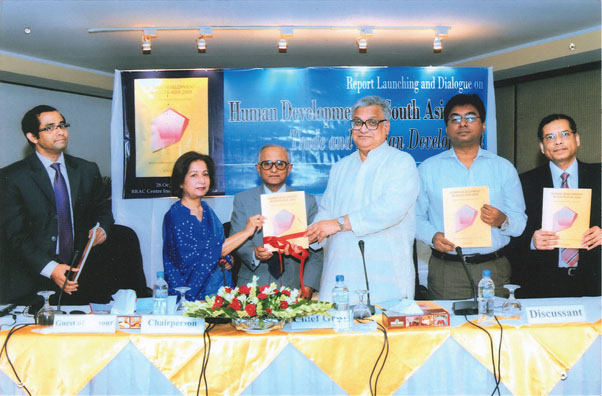The study report on Human Development in South Asia 2009: Trade and Human Development suggested improvement of bilateral relations among the South Asian countries since the region was lagging behind in trade and human development compared to other regions of the world. The report was prepared by Pakistan-based Mahbub ul Haq Human Development Centre (MHHDC) and CPD launched the study report in a dialogue on 28 October 2010, at the BRAC Centre Inn Auditorium, Dhaka. Dr Masihur Rahman, Economic Affairs Advisor to the Hon’ble Prime Minister attended the dialogue as the Chief Guest while Ms Khadija Haq, President of MHHDC was the Guest of Honour. Mr M Syeduzzaman, Member, CPD Board of Trustees and Former Finance Minister chaired the dialogue. Dr Khondaker Golam Moazzem, Senior Research Fellow, CPD made presentation on the report.
According to the report, agricultural trade liberalisation in Bangladesh could result into adverse terms-of-trade which may increase incidence of poverty and inequality of income. Agricultural liberalisation has worsened the overall food security situation of South Asia by increasing the number of hungry people by 2.3 million in every 10 years. Because of the liberalisation, the net food exports remained negative between 1990 and 2006 in all South Asian countries except India. The report noted that projected welfare gains through the emergence of the WTO did not materialise in developing countries as promised in the Uruguay Round, and the trade openness had not led to a decline in poverty. The report also showed that the share of manufacturing sector in output and employment did not rise in tandem with the fall of the share of agricultural sector in GDP which declined to 19 per cent in 2005 from 41 per cent in 1965.
While presenting the report, Dr Moazzem said that due to intra-regional trade facility, 55 per cent of the region’s trade potentials are yet to be tapped despite having huge potentials for regional trade. More than USD 1.8 billion worth of bilateral trade potential between India and Pakistan remains unutilised. On the other hand, India-Bangladesh trade potentials amounted USD 1.6 billion, he added. He pointed out that South Asia as a region witnessed its Human Development Index (HDI) increase from 0.498 in 1995 to 0.617 in 2006, though it remained lower than that of South East Asia (0.687). He mentioned that Trade and Development Index (TDI) rankings between 2005 and 2006 showed that India and Pakistan had been able to improve their TDI rankings during that period, while Bangladesh and Sri Lanka saw their TDI rankings decline, implying that the linkage between trade and development had weakened.
The report stated that developing countries can benefit from South-South trade cooperation. To improve volume of Intra-South Asian trade, different logistic and transaction cost should be minimised. Ms Khadija Haq said that extra-regional trade dominates South Asia’s overall trade structure with 93.7 per cent of the region’s total exports and 96.1 per cent of the region’s total import. Intra-regional trade grew in a very slow rate but extra-regional trade grew at a faster rate, she commented.
The speakers at the dialogue remarked that real development will not take place unless the regional trade opportunities are tapped and trade barriers are removed. They also suggested to reduce transport costs among the South Asian countries. Commenting on the keynote paper, Dr Masihur Rahman said that the fiscal policy of Bangladesh should be attuned to the country’s economic agenda to achieve the growth target. He took note of the positive indicators in the HDI report particularly with regard to women’s empowerment and the role country’s RMG sector has played in this respect.
In his concluding remarks, Mr M Syeduzzaman stated that regional trade in South Asia, particularly between Bangladesh and India, is important from the perspective of economic growth of Bangladesh. He opined that the link between trade, growth and human development has been neither direct nor consistent in South Asian economies. Bangladesh is the only country that has not entered into any new bilateral trade agreement since SAFTA was adopted. Her achievement would be lower than the projections relating to MDGs, Poverty Reduction Strategy and Human Development if she fails to take advantage of regional trade deals, he added.




